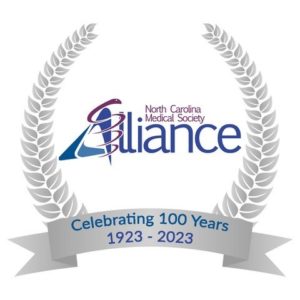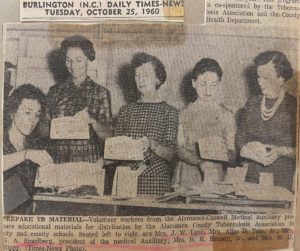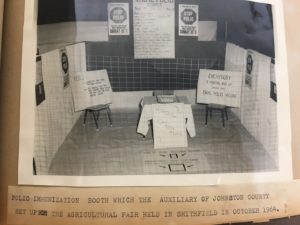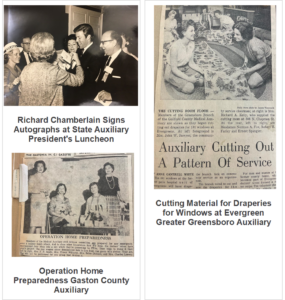
On April 18, 2023, the North Carolina Medical Society Alliance will celebrate its centennial! 100 years of working on one primary mission—to improve the health of all people in North Carolina.
In anticipation of the upcoming centennial celebration, the NCMS Alliance is highlighting its history.
A Look at the 1960s…

1960s Bring Targeted Health Initiatives
The Auxiliary to the Medical Society of the state of North Carolina began the 1960s with a major initiative to address a health issue that is still a top concern today. In 1960, the Auxiliary, under President Trudy (Mrs. Robert L.) Garrard, announced the Mental Health Research Endowment Fund with proceeds going to the Psychiatric Department of the North Carolina Memorial Hospital in Chapel Hill to assist in training and research. The goal was $10,000 which the Auxiliary met in 1967. Members decided to increase the goal to $20,000 and continued to work through the decade to raise those funds. This effort gained national attention during the decade.
Other major health projects of the 1960s also reflect health initiatives today as can be seen in the list of decade highlights below. To meet these challenges, the Auxiliary sought collaboration with other organizations and continued to grow membership. In 1963, President Ursula (Mrs. C. Tolbert) Wilkinson sought permission for the Auxiliary to join the NC Council of Women’s Organizations. She became the first to represent the Auxiliary on the council. In 1967, the Auxiliary appointed its first membership-at-large chairman who worked to establish contact with unorganized counties to gain members. Twenty-two members-at-large joined that first year. Also in that year, the Auxiliary sponsored the first “Day in the Legislature” with over 100 members attending to take an active role in the political process.
Other highlights of the 1960s include—
1960: Mental Health Research Endowment Fund established. The name of the yearbook, an instruction manual for Auxiliaries, became Guide Posts.
1961: The first Health Careers and Health Education Committees were formed.
1962: Medical books were sent to missionaries overseas. The constitution and bylaws were completely revised.
1963: The Auxiliary joined the NC Council of Women’s Organizations. The Research and Romance of Medicine Committee was established to work with that project of the Southern Medical Association Alliance.

1964: The International Health Activities Committee sent many medical books, eyeglasses, drugs, bandages, and equipment overseas. Dr. and Mrs. Joseph Martin Hitch designed a president’s pin.
1965: Mary Johnson was the first to wear the current president’s pin which featured a gold circle with three dogwood flowers, each mounted with a topaz stone mined in the North Carolina mountains. At the close of the 42nd annual meeting she was presented with a smaller replica of the pin.
1966: The first mid-winter Projects Conference was held in Pinehurst. This became an annual event for instruction of county officers and committee chairs. The Robeson County Auxiliary received Honorable Mention at the National Health Mobilization Award contest, presented by the US Heath, Education and Welfare Department, Division of Health Mobilization. Actor Richard Chamberlain (television’s Dr. Kildare) attended the annual luncheon of the president.
1967: The state meeting included television coverage for the first time when Mrs. Dan Moore, NC First Lady spoke at the president’s luncheon. The State Auxiliary was recognized by the state of NC Health Careers Committee for outstanding work with its program of the same name. (see photo “Paramedical Day Held at Rose Club” (on phone) The Robeson County Auxiliary was presented a top award by the Auxiliary of the AMA for its health mobilization effort. The Tarheel Tandem debuted, featuring an illustration of teamwork with a doctor and his wife riding a tandem bike on the masthead. The Auxiliary of the AMA cited theTarheel Tandem as an outstanding newsletter example and used it as a teaching tool. A venereal disease awareness campaign began.
1968: The Community Services and Community Health Committees were combined. The Auxiliary endorsed the Country Doctor Museum in Bailey. The Auxiliary won the Rouse Award for best Research and Romance of Medicine project at the Southern Medical Association Auxiliary meeting.
1969: Family Life Education programs were conducted in local schools. Operation DAMN (Drugs, Alcohol, Marijuana, and narcotics) launched to meet an acute health problem. Suicide prevention and other mental workshops were held throughout the state. Three hundred Auxiliary members and guests attended the “Day in the Legislature” event.

For more information on the NCMS Alliance, its centennial celebration, or to join, click here.
